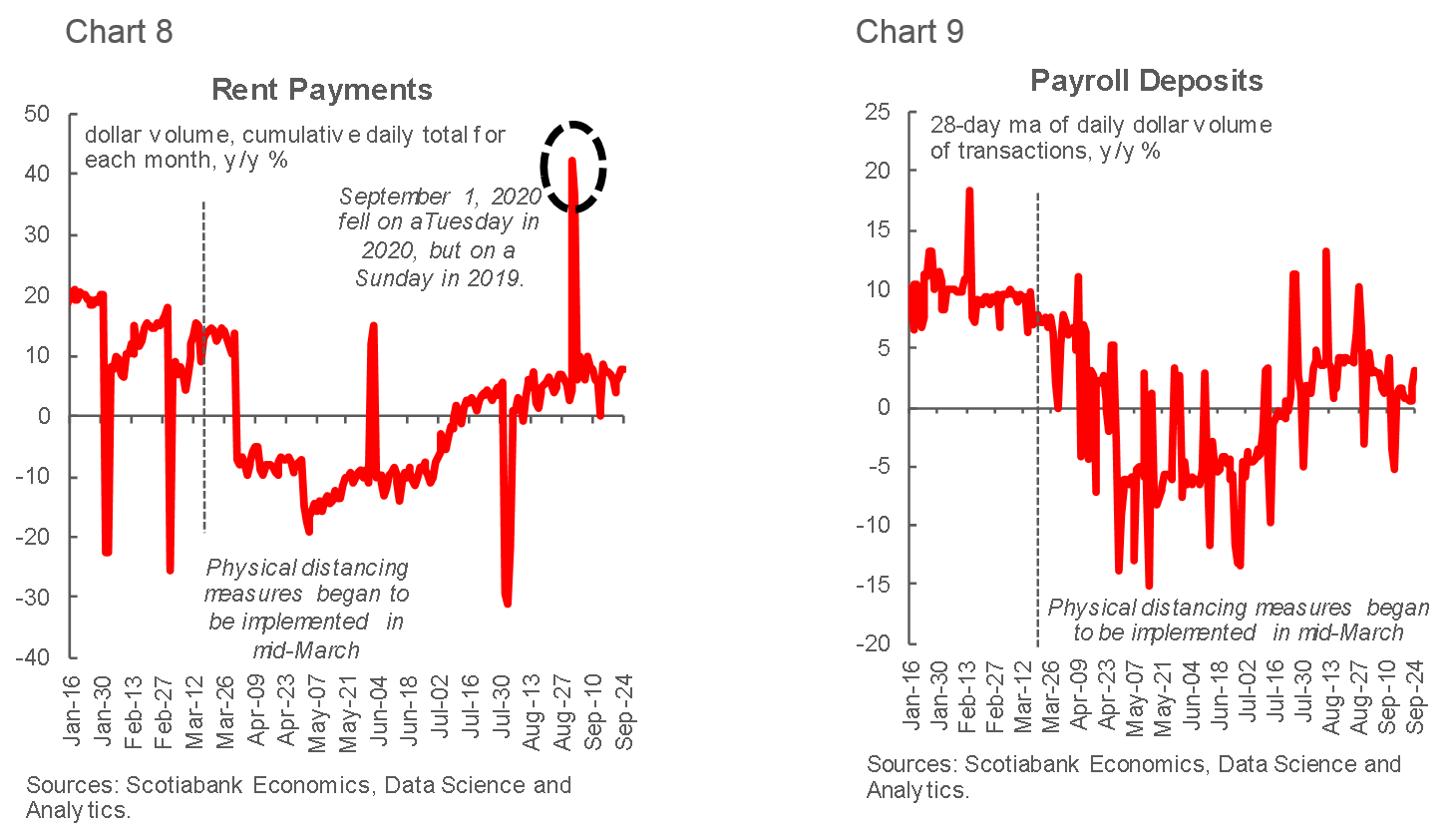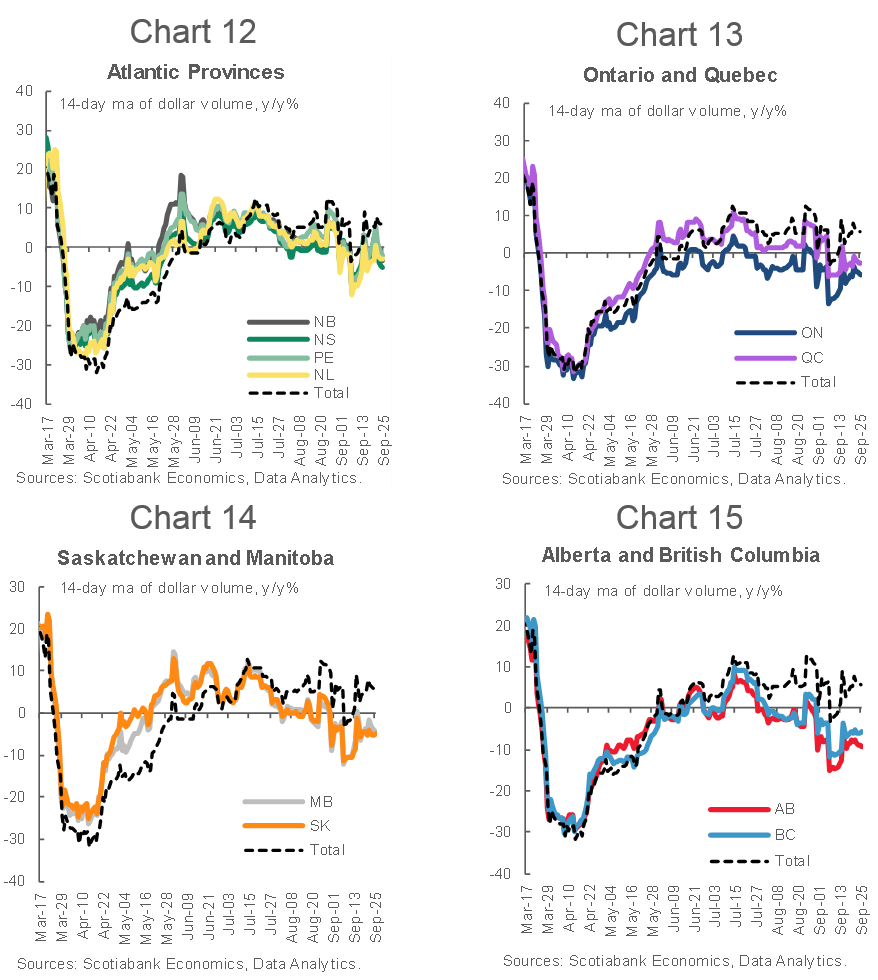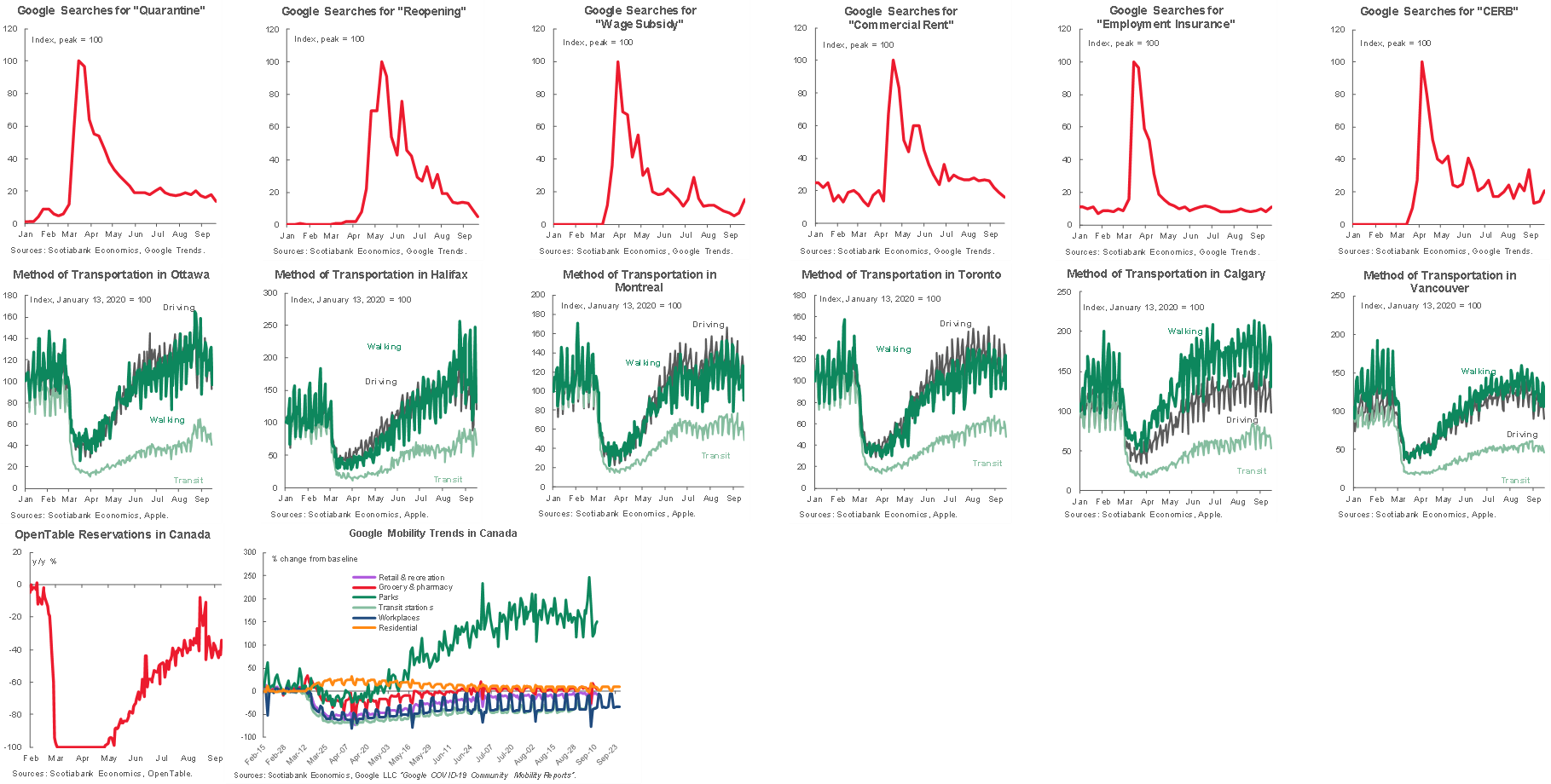Overview
- Key Insights from Customer Transactions
- COVID-19, the Canadian Economy and Scotiabank’s Transactions Data
- Business Transactions Data Details
- Retail Transactions Data Details
- Other High-Frequency Indicators of Activity
1. Key Insights from Canadian Customer Transactions
This presentation is part of the weekly series intended to draw insights about the state of the Canadian economy from the flow of Scotiabank’s retail and non-retail transactions data.
Key takeaways from the payments data in this week’s publication:
- Updated to September 24th, automated funds transfers in the business sector continued to oscillate:
-Growth in incoming transactions remained volatile since the start of September, reversing earlier setbacks and plunging after steep increases. Growth in transactions in the retail sector recovered slightly after the fall earlier in -September, while manufacturing firms showed an increase over the past week. Payments in the transportation industry turned further below the level of 2019 in the last week.
-Growth in payroll deposits continued to track lower in the past week, while rent payments remained relatively stable. In addition, y/y growth in general bill payments has come down in late September compared to earlier in the month. - On the consumer spending side, while concerns of an abrupt slowdown in the pace of the recovery seem to have been premature, the phase of rapid growth appears to have ended. Growth in consumer transactions, available through September 25th, has picked up again after a slowdown in the first half the month:
-The increase in spending was mainly the result of rising home hardware purchases, a rebound in clothing and computer software and related categories. The latter could be the result of schools at all levels increasing the share of online instruction.
-A steady rise in the number of COVID-19 cases across Canada could put a halt to the recovery in retail spending, particularly in vulnerable sectors such as restaurants, entertainment and accommodation services.
2. COVID-19 and the Canadian Economy: Scotiabank Transactions Data
- We present data on retail and non-retail transactions, which capture distinct but related aspects of economic activity in Canada.
- The data comprises actual observed daily transactions going through debit or credit card payment networks in the retail space, and automated funds transfers (AFTs) in the non-retail space.
-The transactions are anonymized and aggregated to protect the privacy of Scotiabank’s clients. - In the current circumstances, comparing the dollar volumes of transactions in the current year and in 2019 can be indicative of the depth of the decline in economic activity in Q2-2020 and help track growth through the re-opening phase.
-Note that the mapping from the volume of transactions to measures of economic activity (e.g. GDP) is imperfect, and so care must be taken when drawing the implications. - The AFT payments show bill payments to/from companies in Canada.
-Incoming payments can be associated with company revenue, and outgoing payments can be associated with costs. - Debit and credit card payments can be used to measure the evolution of retail spending at various types of establishments.
-The transactions can serve as a measure of economy-wide retail spending, and of the extent to which households are resuming pre-COVID levels of activity.
-Note that the use of electronic payments has increased because of COVID-19, so comparisons to year-ago levels can be misleading. These data are best used to observe directional movements rather than to make specific assessments on the level of activity.
2. COVID-19 and the Canadian Economy: Caveats
There are important caveats to analysis based on the payments data:
- The data is observed at daily frequency and embeds different types of seasonal patterns.
-For retail payments, the volume and types of payments are different depending on the day of the week and the season.
-For non-retail payments, both the day of the week and the season are important. In addition, some payments are tied to the calendar date (e.g. rent payments are made on the first day of each month), some payments have a bi-weekly schedule, etc.
-To smooth out most of the day-to-day seasonality we use a 14-day moving average of the dollar volume of transactions, taking a y/y% change to remove any remaining seasonal patterns related to the calendar date. - In addition to seasonality, there is normal payment volatility related to the random nature of the transactions process and the impact of regional and economy-wide events (weather, labour strikes, etc.).
The volatility of this nature may or may not be related to economic activity as measured by GDP and so, as mentioned above, care must be taken in drawing inference. - For business transactions, which are inherently more lumpy compared to retail spending, data towards the end of the sample can be revised as some AFT payments are recorded with a lag. As a result we exclude the last few days of data of business transactions only.
3. Business Transactions Data: Weak Second Half of September
- Automated Funds Transfers (AFT) are used for:
-rent and mortgage payments;
-payroll deposits; and
-other bills. - Growth in incoming transactions remained volatile since the start of September (Chart 1).
- The retail sector recovered slightly after the fall earlier in September and manufacturing firms showed an increase over the past week. The payments in the transportation industry turned even lower compared to the level of 2019 (Charts 2-6).

3. Business Transactions Data: Growth in Retail Payments Stabilized

3. Business Transactions Data: Manufacturing Briefly Rose Above 2019 Level

3. Business Transactions Data: Bill Payments Decline in mid-September
- Y/Y growth in general bill payments declined in late September, compared to earlier in the month (Chart 7). It remains to be seen whether it will recover in the weeks ahead:
-Growth in payroll deposits continued to track lower in the past week, while rent payments remained relatively stable (Charts 8 and 9).
-A declining growth in salary deposits could be a sign of renewed weakness in the labour markets.
-The recent expiration of the federal rent relief program could reduce the volume of rent payments going forward.

3. Business Transactions Data: Payroll Deposit Growth Tracking Lower

4. Retail Transactions Data: Card Spending Growth Picks Up Again
- Growth in consumer transactions, available through September 25th, has picked up again after a slowdown in the first half the month (chart 10):
-The increase is mainly explained by the renewed y/y growth in debit card purchases.
-While concerns of an abrupt slowdown in the pace of the recovery seem to have been premature, the phase of rapid growth appears to have ended.

4. Retail Transactions Data: Use of Bank Machines Still Down
- The volume of transactions through automatic banking machines (ABMs) rose since mid-September, but it remains significantly below last year’s levels (Chart 11).
- As a measure of cash usage, persistently low levels of ABM transactions signal a possible change in preferences, with electronic means gaining at the expense of cash.
- It could also reflect the closure of physical stores and people spending more time at home, with a resulting increase in shopping online reflected in higher electronic payment usage.

4. Retail Transactions Data: Spreading Virus Could Hamper Recovery Across Provinces
- Province-level data show payments stalling in the past few days, despite the increase in total debit and credit transactions. The difference is explained by the rising share of spending at merchants with no recorded province information (Chart 12-15). The increase could reflect more spending at large online stores not tied to a particular province.
- It remains to be seen how virus resurgence across provinces, as well as difficulties with school re-opening, affect spending trends in various parts of the country.

4. Retail Transactions Data: Card Spending Rises In Several Categories
- The pickup in y/y growth in spending in late-September occurred despite further slowing in growth in travel and entertainment spending (Chart 16):
-The largest contribution to the rising growth since mid-September was higher spending on groceries, home hardware, with a smaller share explained by improvements in automotive, clothing, healthcare and computer-related spending.

4. Retail Transactions Data: Travel, Restaurants and Entertainment Spending Slows
- After a relatively brief slowdown in mid-September most hard-hit sectors saw another pickup in growth in latest weeks (Chart 17):
-While Y/Y decline in travel-related spending continued to accelerate, and growth in entertainment and restaurant spending stalled, other sectors showed renewed growth momentum.

4. Retail Transactions Data: Electronic Spending Growth Picked Up in Several Categories
- A recent rebound in y/y growth in spending on computer software and related categories could be the result of schools at all levels increasing the share of online instruction, requiring purchases of electronic equipment and software (Chart 18):
-Y/Y growth in spending on digital goods, as well as telecom services continued to come down in the last few weeks.

5. Other High-Frequency Indicators Of Activity
Charts 19-32 Google Searches, Various Keywords, Dining and Transportation Data

Nikita Perevalov* (Scotiabank Economics)
Taha Jaffer, Jason Liang (Data Science and Analytics)
Roland Merbis, Artur Motruk (Customer Insights & Analytics)
* Director of Economic Forecasting, 437.775.5137, nikita.perevalov@scotiabank.com
DISCLAIMER
This report has been prepared by Scotiabank Economics as a resource for the clients of Scotiabank. Opinions, estimates and projections contained herein are our own as of the date hereof and are subject to change without notice. The information and opinions contained herein have been compiled or arrived at from sources believed reliable but no representation or warranty, express or implied, is made as to their accuracy or completeness. Neither Scotiabank nor any of its officers, directors, partners, employees or affiliates accepts any liability whatsoever for any direct or consequential loss arising from any use of this report or its contents.
These reports are provided to you for informational purposes only. This report is not, and is not constructed as, an offer to sell or solicitation of any offer to buy any financial instrument, nor shall this report be construed as an opinion as to whether you should enter into any swap or trading strategy involving a swap or any other transaction. The information contained in this report is not intended to be, and does not constitute, a recommendation of a swap or trading strategy involving a swap within the meaning of U.S. Commodity Futures Trading Commission Regulation 23.434 and Appendix A thereto. This material is not intended to be individually tailored to your needs or characteristics and should not be viewed as a “call to action” or suggestion that you enter into a swap or trading strategy involving a swap or any other transaction. Scotiabank may engage in transactions in a manner inconsistent with the views discussed this report and may have positions, or be in the process of acquiring or disposing of positions, referred to in this report.
Scotiabank, its affiliates and any of their respective officers, directors and employees may from time to time take positions in currencies, act as managers, co-managers or underwriters of a public offering or act as principals or agents, deal in, own or act as market makers or advisors, brokers or commercial and/or investment bankers in relation to securities or related derivatives. As a result of these actions, Scotiabank may receive remuneration. All Scotiabank products and services are subject to the terms of applicable agreements and local regulations. Officers, directors and employees of Scotiabank and its affiliates may serve as directors of corporations.
Any securities discussed in this report may not be suitable for all investors. Scotiabank recommends that investors independently evaluate any issuer and security discussed in this report, and consult with any advisors they deem necessary prior to making any investment.
This report and all information, opinions and conclusions contained in it are protected by copyright. This information may not be reproduced without the prior express written consent of Scotiabank.
™ Trademark of The Bank of Nova Scotia. Used under license, where applicable.
Scotiabank, together with “Global Banking and Markets”, is a marketing name for the global corporate and investment banking and capital markets businesses of The Bank of Nova Scotia and certain of its affiliates in the countries where they operate, including, Scotiabanc Inc.; Citadel Hill Advisors L.L.C.; The Bank of Nova Scotia Trust Company of New York; Scotiabank Europe plc; Scotiabank (Ireland) Limited; Scotiabank Inverlat S.A., Institución de Banca Múltiple, Scotia Inverlat Casa de Bolsa S.A. de C.V., Scotia Inverlat Derivados S.A. de C.V. – all members of the Scotiabank group and authorized users of the Scotiabank mark. The Bank of Nova Scotia is incorporated in Canada with limited liability and is authorised and regulated by the Office of the Superintendent of Financial Institutions Canada. The Bank of Nova Scotia is authorised by the UK Prudential Regulation Authority and is subject to regulation by the UK Financial Conduct Authority and limited regulation by the UK Prudential Regulation Authority. Details about the extent of The Bank of Nova Scotia's regulation by the UK Prudential Regulation Authority are available from us on request. Scotiabank Europe plc is authorised by the UK Prudential Regulation Authority and regulated by the UK Financial Conduct Authority and the UK Prudential Regulation Authority.
Scotiabank Inverlat, S.A., Scotia Inverlat Casa de Bolsa, S.A. de C.V., and Scotia Derivados, S.A. de C.V., are each authorized and regulated by the Mexican financial authorities.
Not all products and services are offered in all jurisdictions. Services described are available in jurisdictions where permitted by law.

